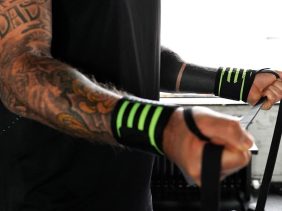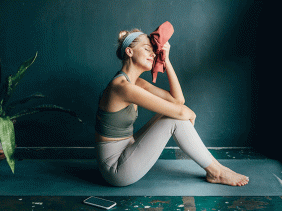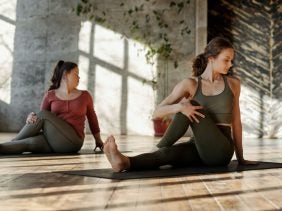7 Moves to Help You Do the Splits
 ©PeopleImages
©PeopleImages
Listen, there’s a reason that splits are the purview of children and the very bendy. It’s hard! But that doesn’t mean you can’t do it. We’re just letting you know you’re embarking on a journey and the best place to start is improving your flexibility.
7 key stretches for longitudinal splits
Get into each of the moves slowly. Slowly find your “sticking point”—the place where your flexibility maxes out. Stay there for a moment, then come out of the position carefully. “Slowly” is the name of the game. When you feel like you’ve reached a stretch that’s comfortable but challenging, hold it for 30 seconds, breathing deeply and calmly throughout. Repeat on the other side. Repeat on each side a few times. You might feel you’re able to get deeper into the stretch with every rep. But that’s not the only way to measure progress—the other method is time. You may find that the intensity for some stretches is too much to hold for 30 seconds. So start with five or 10 seconds at a go, giving yourself a break between each rep. That’s ok! Your neuromuscular system is getting accustomed to doing something new.
These supplements will help keep your body on tip-top form
Breathing is key. If you’re holding your breath, your body is on high-alert, and you can’t relax. It’s only when our muscles relax that they’ll become flexible enough to achieve the splits. If it feels like you’re trying to survive a certain pose, it means it’s too challenging for you at that time. Do a slightly easier variation until you feel comfortable and able to breathe throughout the rep. Then move onto a more challenging version.
When you’re able to do all the poses comfortably, test out your longitudinal splits. A good way to do this is by stacking rolled blankets or yoga bolsters for support, and seeing how far you can go in the half splits. Provide yourself more support than you think you’ll need. You can always remove some on your next attempt.
- Couch stretch
Start by kneeling on a cushion or yoga mat facing away from a wall. Place right foot on floor, with right knee at a 90° angle; with left knee on the floor, place the top of the left foot on wall. Move left knee as near or far from the wall as is comfortable while keeping torso upright, hands on hips, pressing hips forward. Reverse to start and switch sides. When you’re comfortable, place one knee where the floor meets the wall, with shin flush against the wall.
- Low lunge
Start on hands and knees. Press into hands, draw left knee toward chin, and place left foot on the floor between hands. Lift torso upright, placing hands on left knee, and shift right leg back along floor until you feel a stretch in your hips. Reverse to start and switch sides. To increase difficulty, place the toes and ball of your back foot on the floor and lift back knee.
- Standing bend
Start standing with feet shoulder width apart, then step left foot back far enough that you feel a stretch. Squeeze your buttock muscles for balance, and fold torso over right leg, placing hands on right shin. Maintaining straight legs, press into hands and shift hips back until you feel a stretch. Reverse to start and switch sides. If that’s too intense, instead of placing hands on shin, rest them on thigh, or a wall or chair. To make it more difficult, place two yoga blocks on floor on either side of forward foot and rest hands on top of block. When that’s too easy, remove blocks and place hands on floor.
Related: More performance in the gym through mobility training
- Half pigeon pose
Start in a high plank, with shoulders over wrists. Pull left knee toward chin, then bend elbows to lower, allowing the left side of your left leg to rest on the floor. Shift weight forward and adjust left leg so left knee is at a 45° angle from body, and left heel is near pelvis. Straighten back leg, square hips, and lift torso, placing hands on floor for balance. Reverse to start and switch sides. If that’s too intense, use a blanket or yoga block under hips, find a more comfortable angle with the front leg, or press torso up a few seconds at a time and then fold forward to rest. If it’s too easy, increase the angle of the front knee up to 90° curl back toes onto mat.
- Lying hamstring stretch
Start on your back. Keeping legs straight, raise left leg and grab back of thigh with both hands. Keeping torso relaxed and back on floor, pull leg closer to face. Reverse to start and switch sides. If that’s too hard, place right foot on floor while left leg comes to you, or use a yoga strap around the bottom of foot and pull foot back. If this is too easy, grab the toes on your left foot and draw foot back behind your head.
Refuel: Try our whey protein either before or after exercising
- Calf stretch
Start on a step, standing on the balls of your feet, heels over the edge, holding onto a railing. Press calves down until you feel a stretch. If that’s too challenging, do it one foot at a time. If it’s too easy, lower heels and hold.
- Half splits
Start in a low lunge, right knee on floor, right leg creating a 90° angle, left foot in front with left heel on floor, toes pointed up. Keeping torso engaged, fold forward, making sure your back doesn’t round, and place hands on either side of left leg. Reverse to start and switch sides. If that’s too hard, put yoga blocks on either side of left leg to use as handholds. If that’s too easy, push right knee back to create a bigger angle with legs.
More healthy living tips from foodspring:
- Weight Loss Workout Plan: What you need to know
- How to Lose Weight with Yoga
- How to lose weight without dieting: 13 tips to your feel-good body
- Create your ideal weight loss meal plan and work towards your feel-good body!
- Weight Lifting For Weight Loss
Sources for this article
We at foodspring use only high-quality sources, including peer-reviewed studies, to support the facts within our articles. Read our editorial policy to learn more about how we fact-check and keep our content accurate, reliable, and trustworthy.






















